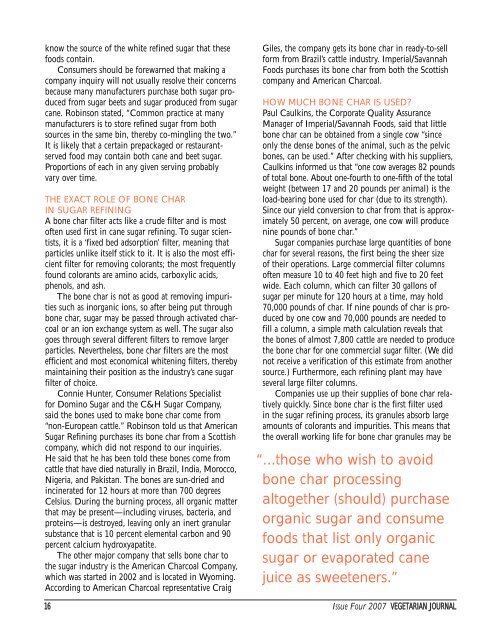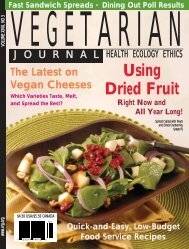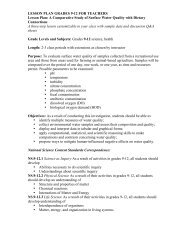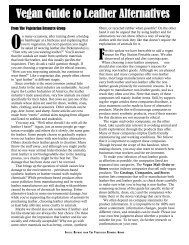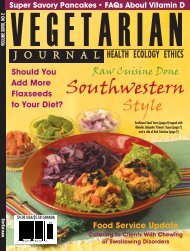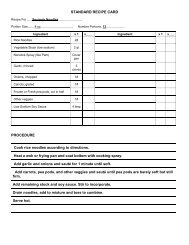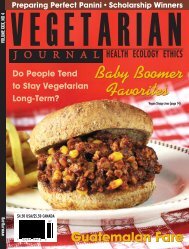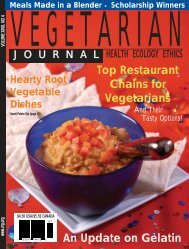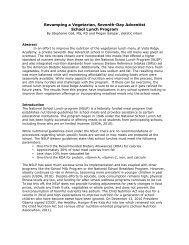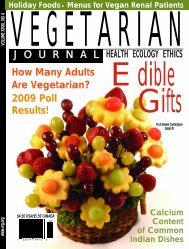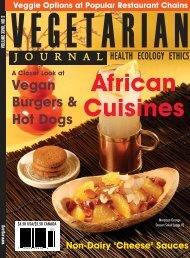Is Your Sugar Vegan? - The Vegetarian Resource Group
Is Your Sugar Vegan? - The Vegetarian Resource Group
Is Your Sugar Vegan? - The Vegetarian Resource Group
Create successful ePaper yourself
Turn your PDF publications into a flip-book with our unique Google optimized e-Paper software.
know the source of the white refined sugar that these<br />
foods contain.<br />
Consumers should be forewarned that making a<br />
company inquiry will not usually resolve their concerns<br />
because many manufacturers purchase both sugar produced<br />
from sugar beets and sugar produced from sugar<br />
cane. Robinson stated, “Common practice at many<br />
manufacturers is to store refined sugar from both<br />
sources in the same bin, thereby co-mingling the two.”<br />
It is likely that a certain prepackaged or restaurantserved<br />
food may contain both cane and beet sugar.<br />
Proportions of each in any given serving probably<br />
vary over time.<br />
THE EXACT ROLE OF BONE CHAR<br />
IN SUGAR REFINING<br />
A bone char filter acts like a crude filter and is most<br />
often used first in cane sugar refining. To sugar scientists,<br />
it is a ‘fixed bed adsorption’ filter, meaning that<br />
particles unlike itself stick to it. It is also the most efficient<br />
filter for removing colorants; the most frequently<br />
found colorants are amino acids, carboxylic acids,<br />
phenols, and ash.<br />
<strong>The</strong> bone char is not as good at removing impurities<br />
such as inorganic ions, so after being put through<br />
bone char, sugar may be passed through activated charcoal<br />
or an ion exchange system as well. <strong>The</strong> sugar also<br />
goes through several different filters to remove larger<br />
particles. Nevertheless, bone char filters are the most<br />
efficient and most economical whitening filters, thereby<br />
maintaining their position as the industry’s cane sugar<br />
filter of choice.<br />
Connie Hunter, Consumer Relations Specialist<br />
for Domino <strong>Sugar</strong> and the C&H <strong>Sugar</strong> Company,<br />
said the bones used to make bone char come from<br />
“non-European cattle.” Robinson told us that American<br />
<strong>Sugar</strong> Refining purchases its bone char from a Scottish<br />
company, which did not respond to our inquiries.<br />
He said that he has been told these bones come from<br />
cattle that have died naturally in Brazil, India, Morocco,<br />
Nigeria, and Pakistan. <strong>The</strong> bones are sun-dried and<br />
incinerated for 12 hours at more than 700 degrees<br />
Celsius. During the burning process, all organic matter<br />
that may be present—including viruses, bacteria, and<br />
proteins—is destroyed, leaving only an inert granular<br />
substance that is 10 percent elemental carbon and 90<br />
percent calcium hydroxyapatite.<br />
<strong>The</strong> other major company that sells bone char to<br />
the sugar industry is the American Charcoal Company,<br />
which was started in 2002 and is located in Wyoming.<br />
According to American Charcoal representative Craig<br />
Giles, the company gets its bone char in ready-to-sell<br />
form from Brazil’s cattle industry. Imperial/Savannah<br />
Foods purchases its bone char from both the Scottish<br />
company and American Charcoal.<br />
HOW MUCH BONE CHAR IS USED<br />
Paul Caulkins, the Corporate Quality Assurance<br />
Manager of Imperial/Savannah Foods, said that little<br />
bone char can be obtained from a single cow “since<br />
only the dense bones of the animal, such as the pelvic<br />
bones, can be used.” After checking with his suppliers,<br />
Caulkins informed us that “one cow averages 82 pounds<br />
of total bone. About one-fourth to one-fifth of the total<br />
weight (between 17 and 20 pounds per animal) is the<br />
load-bearing bone used for char (due to its strength).<br />
Since our yield conversion to char from that is approximately<br />
50 percent, on average, one cow will produce<br />
nine pounds of bone char.”<br />
<strong>Sugar</strong> companies purchase large quantities of bone<br />
char for several reasons, the first being the sheer size<br />
of their operations. Large commercial filter columns<br />
often measure 10 to 40 feet high and five to 20 feet<br />
wide. Each column, which can filter 30 gallons of<br />
sugar per minute for 120 hours at a time, may hold<br />
70,000 pounds of char. If nine pounds of char is produced<br />
by one cow and 70,000 pounds are needed to<br />
fill a column, a simple math calculation reveals that<br />
the bones of almost 7,800 cattle are needed to produce<br />
the bone char for one commercial sugar filter. (We did<br />
not receive a verification of this estimate from another<br />
source.) Furthermore, each refining plant may have<br />
several large filter columns.<br />
Companies use up their supplies of bone char relatively<br />
quickly. Since bone char is the first filter used<br />
in the sugar refining process, its granules absorb large<br />
amounts of colorants and impurities. This means that<br />
the overall working life for bone char granules may be<br />
“...those who wish to avoid<br />
bone char processing<br />
altogether (should) purchase<br />
organic sugar and consume<br />
foods that list only organic<br />
sugar or evaporated cane<br />
juice as sweeteners.”<br />
16 <strong>Is</strong>sue Four 2007 VEGETARIAN JOURNAL


